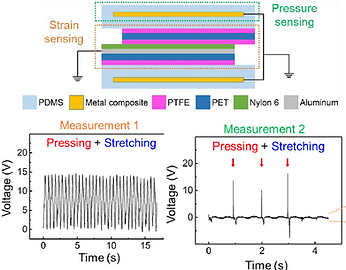Electronic Skin Sensor System
-
Stretchable Strain Sensor
Mechanical monitoring of our body is an emerging requirement for next generation human-friendly electronics, which can measure not only tiny bio-signals such as wrist pulse, apexcardiogram and facial expression, but large motions like joint and muscle motions. Strain sensing is a basic function of the sensor system and the physical intimacy could be acquired with softness or stretchability of the materials comprising sensors. We are developing the stretchable conducting materials based on 0-D, 1-D, 2-D nanomaterials with chemical and physical elastomer (block-copolymer) for strain sensor application.
Fibril structured deposited gold film


Adv. Mater., 2018, 30, 1801408
ACS Appl. Mater. Interfaces, 2018, 10, 40141-40148
2-D percolation based Heart monitoring device

Adv. Mater., 2016, 28, 6359-6364
-
Tactile Sensor
Tactile sensing is the most important function comprising electronic skin system. As a substitute for mechanoreceptor in human skin, it feels external mechanical stimulation like pressure and strain and transduces to electrical signals. Film type high sensitive pressure sensor has been used to measure small bio-signals. In our lab, we are fabricating various type of pressure sensor matrix array for different purpose. On-skin sensors measured pressure profiles in small scale like human cutaneous system, that were utilized as Braille scanner and also showed potentials for prosthetics or robot skin application. Additionally, we are also interested in active tactile sensors using self-power generating system.
Conductive Microparticle based pressure sensor array

Adv. Funct. Mater., 2018, 28, 1801858
Active tactile sensing with Triboelectricity

Nano energy, 2019, 56, 347
-
Bioelectrical Signal Sensor
Recently, people want to take care their health condition in real time. There are electrical signals from our body such as electrocardiogram, electroencephalogram…etc. These signals help us to diagnose health condition of our body. Mobile healthcare devices want to measure these electrical signals. To measure these signals, it is important to have conformal contact between the sensor and the skin. Because skin shows dynamic movement, this sensor should be stretchable. The device also should have breathability and make sweat evaporate easily for long-term use. All materials in the sensor must be biocompatible and robust. In our lab, bioelectrical signal sensors are fabricated using hydrogels, conductive polymers and nanoparticles. In the future, we will develop this research from on-skin wearable sensors to implantable sensors.
Breathable electrocardiogram sensor


ACS Appl. Mater. Interfaces, 2018, 10, 40141-40148
